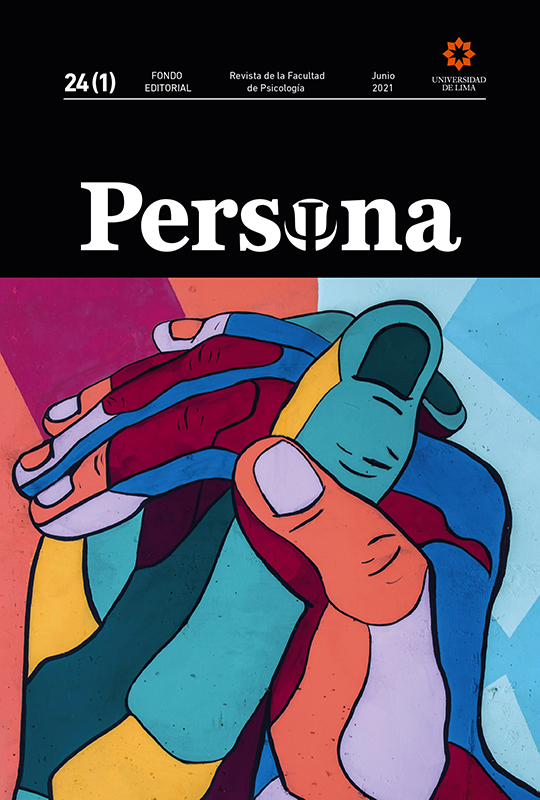Adaptación de una escala de tácticas de autopresentación en una muestra mexicana
DOI:
https://doi.org/10.26439/persona2021.n024(1).5310Palabras clave:
impresiones, imagen pública, psicometría, validez, confiabilidadResumen
La autopresentación permite a las personas mostrar una imagen deseada en un afán de pertenecer a diferentes grupos y sentirse bien; por ello, es relevante contar con instrumentos que permitan medir dicho constructo apropiadamente. Este estudio tuvo por propósito adaptar la escala de tácticas de autopresentación (ETA) en una muestra de adultos de la Ciudad de México y área metropolitana. Participaron 626 voluntarios de entre 18 y 60 años. Se obtuvo un instrumento conformado por siete factores que explican el 52 % de la varianza, con un alfa de Cronbach de .90 y con evidencias convergentes de validez al estar correlacionada con la escala de manejo de impresiones de Bolino y Turnley y la escala de necesidad de aprobación social. En conclusión, existen evidencias de validez y confiabilidad que sustentan el uso de la ETA. Además, se apoyó la premisa de que algunas tácticas pueden configurarse de manera diferente dependiendo del contexto cultural, mientras que otras se presentan análogamente en múltiples culturas.
Descargas
Referencias
Bolino, M., y Turnley, W. (1999). Measuring Impression Management in Organizations: A Scale Development Based on the Jones and Pittman Taxonomy. Organizational Research Methods, 2(2), 187-206. https://doi.org/10.1177/109442819922005
Bonner, J., Greenbaum, R., y Quade, M. (2017). Employee Unethical Behavior to Shame as an Indicator of Self-Image Threat and Exemplification as a Form of Self-Image Protection: The Exacerbating Role of Supervisor Bottom-Line Mentality. Journal of Applied Psychology, 102(8), 1203-1221. https://doi.org/10.1037/apl0000222
Bye, H., Sandal, G., Van de Vijver, F., Sam, D., Cakar, N., y Franke, G. (2011). Personal Values and Intended Self-Presentation During Job Interviews: A Cross-Cultural Comparison. Applied Psychology: An International Review, 60, 160-182. https://doi.org/10.1111/j.1464-0597.2010.00432.x
Costa, P., y McCrae, R. (1999). NEO PI-R, inventario de personalidad neo revisado. NEO-FFI, inventario neo reducido de cinco factores. TEA Ediciones.
Crowne, D., y Marlowe, D. (1964). The Approval Motive. Wiley.
Domínguez, A., y Van de Vijver, F. J. (2014). An Indigenous Social Desirability Scale. Measurement and Evaluation in Counseling and Development, 47(3), 199-214. https://doi.org/10.1037/t45076-000
Domínguez, A., Velasco, P., Aguilera, S., y Contreras, M. (2019). Validation of the Bolino and Turnley’s Impression Management Scale in a Mexican Sample. Acta de Investigación Psicológica, 9(3), 90-99. https://doi.org/10.22201/fpsi.20074719e.2019.3.325
González, A., Velasco, P., y Tavizón, B. (2017). Estrategias de manejo de impresiones y su relación con variables psicológicas. Revista Especializada en Ciencias de la Salud, 20(2), 12-21. https://www.medigraphic.com/cgi-bin/new/resumen.cgi?IDARTICULO=82568
Gross, C., Debus, M., Liu, Y., Wang, M., y Kleinmann, M. (2020). I am Nice and Capable! How and When Newcomers’ Self-Presentation to Their Supervisors Affects Socialization Outcomes. Journal of Applied Psychology. Advance online publication. https://doi.org/10.1037/apl0000817
Hart, W., Tortoriello, G., Richardson, K., y Breeden, C. (2019). Profiles and Profile Comparisons Between Dark Triad Constructs on Self‐Presentation Tactic Usage and Tactic Beliefs. Journal of Personality, 87(3), 501-517. https://doi.org/10.1111/jopy.12411
Hofstede, G., Hofstede, G. J., y Minkov, M. (2010). Cultures and Organizations: Software of the mind (3.a ed.). Mc Graw Hill.
Hogan, T. (2015). Psychological Testing: A Practical Introduction (3.a ed.). John Wiley & Sons, Inc.
Howard, M. (2016). A Review of Exploratory Factor Analysis Decisions and Overview of Current Practices: What We Are Doing and How Can We Improve? International Journal of Human-Computer Interaction, 32(1), 51-62. https://doi.org/10.1080/10447318.2015.1087664
International Test Commission. (2017). ITC Guidelines for Translating and Adapting Tests (2.a ed.). International Journal of Testing, 18(2), 101-134. https://doi.org/10.1080/15305058.2017.139816
Jones, E., y Pittman, T. (1982). Toward a General Theory of Strategic Self-Presentation. En J. Suls (Ed.), Psychology Perspectives on the Self (pp. 231-262). Erlbaum.
Kim, J., y Lee, J. (2011). The Facebook Paths to Happiness: Effects of the Number of Facebook Friends and Self-Presentation on Subjective Well-Being. Cyberpsychology, Behavior, and Social Networking, 14(6), 359-364. https://doi.org/10.1089/cyber.2010.0374
Kim, J., Lee, S., y Gim, W. (2011). Culture and Self-Presentation: Influence of Social Interactions in an Expected Social Relationship. Asian Journal of Social Psychology, 14, 63-74. https://doi.org/10.1111/j.1467-839X.2010.01332.x
Leary, M., Allen, A., y Terry, M. (2011). Managing Social Images in Naturalistic Versus Laboratory Settings: Implications for Understanding and Studying SelfPresentation. European Journal of Social Psychology, 41(4), 411-421. https://doi.org/10.1002/ejsp.81
Leary, M., y Jongman, K. (2017). Self-Presentation: Signaling Personal and Social Characteristics. En J. Burgoon, N. Magnenat, M. Pantic, y A. Vinciarelli (Eds.), Social Signal Processing (pp. 69-77). Cambridge University Press.
Leary, M., y Kowalski, R. (1990). Impression Management: A Literature Review and Two Component Model. Psychological Bulletin, 107, 34-47. https://doi.org/10.1037/0033-2909.107.1.34
Lee, S., Quigley, B., Nesler, M., Corbett, A., y Tedeschi, J. (1999). Development of a SelfPresentation Tactics Scale. Personality and Individual Differences, 26(4), 701-722. https://doi.org/10.1016/S0191-8869(98)00178-0
Molden, D., Lucas, G., Gardner, W., Dean, K., y Knowles, M. (2009). Motivations for Prevention or Promotion Following Social Exclusion: Being Rejected Versus Being Ignored. Journal of Personality and Social Psychology, 96(2), 415-431. https://doi.org/10.1037/a0012958
Nunnally, J., y Bertstein, I. (1995). Teoría psicométrica. McGraw Hill.
Osborn, J., y Costello, A. (2004). Sample Size and Subject to Item Ratio in Principal Components Analysis. Practical Assessment, Research y Evaluation, 9(11), 1-9. https://doi.org/0.7275/ktzq-jq66
Paulhus, D., y Trapnell, P. (2008). Self-Presentation on Personality Scales: An AgencyCommunion Framework. En O. John, R. Robins, y L. Pervin (Eds.), Handbook of Personality (pp. 492-517). Press.
Reyes-Lagunes, I., y García, L. (2008). Procedimiento de validación psicométrica culturalmente relevante: un ejemplo. En S. Rivera, R. Díaz, R. Sánchez e I. ReyesLagunes (Eds.), La psicología social en México (vol. XII, pp. 625-636). AMEPSO.
Sadler, M., Hunger, J., y Miller, C. (2010). Personality and Impression Management: Mapping the Multidimensional Personality Questionnaire into 12 Self-Presentation Tactics. Personality and Individual Differences, 48(5), 623-628. https://doi.org/10.1016/j.paid.2009.12.020
Safhi, M., y Teleb, A. (2016). Comparison of Self-Presentation Tactics Between Visually Impaired and Sighted Students. Journal of Arabic Studies in Education y Psychology, 69, 297-314. https://doi.org/10.12816/0022660
Sandal, G., Van de Vijver, F., Bye, H., Sam, D., Amponsah, B., y Cakar, N. (2014). Inteded
Self-Presentation Tactics in Job Interviews: A 10-Country Study. Journal of CrossCultural Psychology, 45(6), 1-20. https://doi.org/10.1177/0022022114532353
Serap, O., Durna, G., y Araz, A. (Julio, 2019). The Turkish Adaptation of Self-Presentation Tactics Scale: Preliminary Results [Sesión de póster]. XVI European Congress of Psychology, Moscú, Rusia.
Smith, A., Watkins, M., Burke, M., Christian, M., Smith, C., Hall, A., y Simms, S. (2013). Gendered Influence A Gender Role Perspective on the Use and Effectiveness of Influence Tactics. Journal of Management, 39(5), 1156-1183. https://doi.org/10.1177/0149206313478183
Sociedad Mexicana de Psicología. (2010). Código Ético del Psicólogo (5.a ed.). Editorial Trillas.
Tedeschim, J., y Melburg V. (1984). Impression Management and Influence in the Organization. En S. Bacharach y E. Lawler (Eds.), Research in the Sociology of Organizations (pp. 31-58). JAI.
Urdan, T., y Midgley, C. (2001). Academic Self-Handicapping: What we Know, What More There is to Learn. Educational Psychology Review, 13, 115-138. https://doi.org/10.1023/A:1009061303214
Velasco, P. y Bonilla, C. (2020). Efectos de la discriminación percibida en una muestra de jóvenes mexicanos. En I. Blanca (Ed.), Aportaciones de la psicología al bienestar del ser humano (pp. 121-135). Universidad Nacional Autónoma de México.
Velasco, P., Rivera, S., García, M., y Díaz-Loving, R. (2018). Discriminación, manejo de impresiones y habilidades para la vida como predictores del bienestar. En R. Díaz Loving, L. Reyes-Lagunes y F. López. La psicología social en México (vol. XVII). AMEPSO.
Publicado
Número
Sección
Licencia
La aceptación de publicación implica ceder los derechos de impresión y de reproducción por cualquier forma y medio al editor, manteniendo el autor la propiedad intelectual del artículo.











